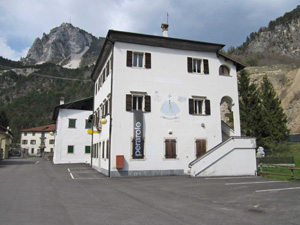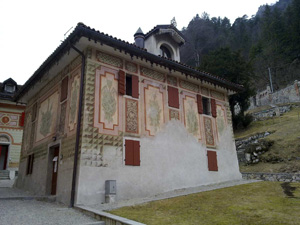| Card n. | Description | Locality | Linked sites |
| 24 | Perarolo | Perarolo di Cadore | 50 - 49 - 61 - 70 - 102 |
| file .pdf | Architecture Art History (ASA) - Ethnographic Sites (SE) | Google maps |
 |
 |
 |
- Description
- How to get there
- Interesting facts
- Bibliography
From Perarolo di Cadore to Longarone, along the “canal of the Piave”, the level of the river is fairly low, and the waters flow virtually undisturbed through an area that was once a busy centre for the floating, sorting and processing of timber. In Perarolo, a river port and an important commercial hub at the confluence of the Boite and the Piave, the “Cidolo” and Timber Museum (61 SE), which opened in 2005, offers visitors the chance to learn about and reflect on this area. The rogge, or irrigation channels that were used to supply the water to run the sawmills, were buried below ground towards the middle of the 20th century. In the mid-17th century, in Sacco (49 HAA) a wooden structure was built as a sort of covered bridge designed to stem the trunks that were floated down from the Piave, which were piled up upstream, allowing for their recovery; downstream from this structure, typical of the Cadore area and known as “cidolo”, were the sawing establishments. One of the most interesting buildings in the centre of the village - all of which feature architectural styles different from those found in the other villages in the Cadore – is Palazzo Lazzaris, which boasts interesting decorations and an Italian-style garden, and was the elegant dwelling of the Lazzaris family, who became rich in the 19th century thanks to their timber trade business. Of the numerous industrial establishments that existed in Perarolo until the mid-20th century, the only surviving example is the Del Favero forge (70 IA), in which we can still see all the working tools, the preparatory drawings, the machines and the manually-operated bellows for fanning the fire. One of the most important industrial workshops along the flow of the Piave, which has now disappeared, was built from the 16th century onwards in Venago, opposite the neighbourhood of Rucorvo, on the left side of the river, while at Ansogne, just a little further upstream, the painter Titian owned a sawmill during the same century.
Perarolo can be reached by following the old SS51 Alemagna road from Belluno; if you take the SS51 from the Cadore before the bridge of the same name, take the Cavallera road or follow the signs at Caralte for Perarolo.
ACCESSIBLE: yes
MUNICIPALITY: Perarolo di Cadore
PLACE: Various sites located between the Centro Cadore dam and Ospitale
GEOGRAPHICAL COORDINATES: X 1757963 – Y 5143732 (centre of the village of Perarolo)
PROVINCE: Belluno
FILE COMPILED BY: Antoniol/Bonato
In 1994, the isolated, impenetrable Valmontina (102 NS), south of Perarolo, was designated a Wilderness Area on account of its unspoilt nature and minimal human presence.
R. Tabacchi, D. De Martin, Uomini e macchine idrauliche nel Cadore d’inizio Novecento, Cortina d’Ampezzo, 2010
Various Authors, Il Piave, Verona, 2000;
Various Authors, Il Veneto paese per paese, Florence, 1998
S. De Lorenzo, Il Centenaro di Valle di Cadore, Valle di Cadore, 1998
G. Caniato, La via del Fiume dalle Dolomiti a Venezia, Verona, 1993
F. Zangrando, Perarolo di Cadore. Dal Cidolo al duemila, Treviso, 1990
D. Perco, Rafts, zattieri e menadàs. La fluitazione del legname lungo il Piave, Feltre, 1988
F. Zangrando, Perarolo di Cadore. Il paese del Cidolo, Treviso, 1985
Various Authors I manufatti e le aggregazioni rurali nella Comunità Montana Cadore-Longaronese-Zoldano, Belluno, 1984
B. Zanenga, Viaggio lungo il Piave nel secolo XVI. Dalle Antichità Bellunesi di Pierio Valeriano, Casteldardo, Rome, 1966

